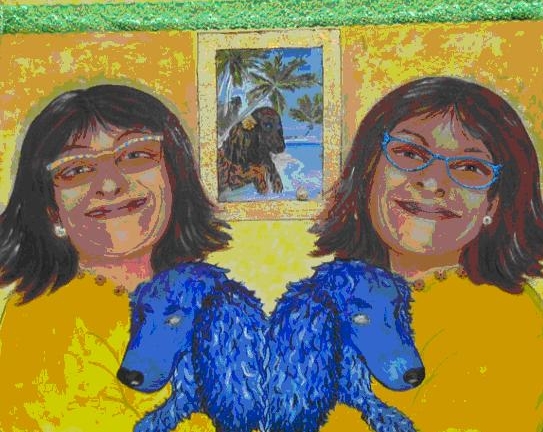
Das doppelte Lena, Autoportrait, 2007
How Nets can reveal who made them,
who wore them,
when and how they were made
Lena Bjerregaard
(Textile Conservator, Ethnologisches Museum, Berlin)
The archaeological Peruvian department in Ethnologisches Museum in Berlin has a collection of 56 knotted hairnets. These hairnets have not been studied closely before now, and many have ended up in other museum collections around the world turned upside down and titled: bags. However some of these nets are in Ethnologisches Museum still sitting on mummified heads and their correct use can therefore be defined.
Studying ceramic dolls in the museum collection together with written sources it has been possible to define who, when and where they were worn.
Who, where and when?
In many places in the world, where ethnic clothing is still used, head gear sharply indicates geographic affiliation (Golden Triangle, Tibet, Mexico, Central and South America), and so it was in pre-Spanish America too. Furthermore, head gear in those days, as well as in some places still today, indicated hierarchical status or trade (chef's hat). Especially in the Inca society, where all the fine textiles - cumbi - belonged to the emperor and were distributed by him at his will, it was necessary still to distinguish among the different higher classes. This was done through their head gear.
In 1880-87, Wilhelm Reiss and Alphons Stübel, who undertook archaeological excavations in Ancon on the central coast of Peru, and in 1875 they published three volumes with wonderful watercolor illustrations of their excavations. Most of the artefacts ended up in Ethnologisches Museum.

This illustration shows a mummy bundle opened, and cut in half. And the mummy is wearing a hairnet!
The text for the illustration says that unspecified weaving tools were inside this mummy bundle. A backstrap loom, complete with rods and beater, is tied to the outside of the mummy bundle, and sticks wound with yarns has miniature cones with cotton fiber prepared for spinning attached at the top.
A natural conclusion, which already Wilhelm Reiss and Alphons Stübel made, is that the person inside this Ancon mummy bundle was a weaver - wearing a hairnet.
Both men and women were professional weavers in the Inka society. The finest weavings were made by the Aclla (cloistered women) and the next finest by professional male weavers (cumbi camayocs). Fine textiles were extremely highly prized and the weavers had high status in the hierarchy. We assume this was the case in the previous pre-Columbian cultures as well. The illustrated mummy bundles are obviously containing people from the upper ranks of society - very likely local professional weavers - whether male or female.
A mummy head in Ethnologisches Museum's collection wearing a hairnet -was tested for its gender by the forensic anthropologist John Verano (Tulane University) and he concluded that it was probably male.
Two stylized anthropomorphic ceramic figurines (called Cuchimilcos ) from the Chancay Culture - 1300 - 1500 AD, from the central coast of Peru belonging to the Metropolitan Museum show a man and a woman each wearing a hairnet!
A number of ceramic Chancay figurines in Ethnologisches Museum are either female or without sexual attributes - and are wearing the same kind of hairnets.
I therefore suggest, that weavers (although maybe not exclusively), being male or female on the middle coast of Peru, around AD 1300-1500 were wearing these hairnets.
What?
In pre-Spanish Peru mainly wool from the alpaca and cotton were used in textile production. But also plant fibers - especially from a plant called Fourcreae Andina which belongs to the Agave family - were used. Fourcreae was made into thread as fine as linen and used for tunics as an alternative to cotton. The fiber is still grown, processed and used for making bags in Ecuador. The thick leaves of the Fourcreae are split, beaten, retted, dried, combed and spun much in the same way as linen.
We made raster microscopy photographs (scanning electron microscope) of the archaeological net fibers, and by comparing them to reference fiber material concluded that the nets were actually made from Fourcreae.
The nets are knotted and many of them have patterns in a technique that resembles tatting - a knotting technique which was very popular in the Western World a hundred years ago, and which was mainly used for creating lace-like edges on handkerchiefs, scarves etc. It was a long way to come to this conclusion, as the so similar technique have such different end products.

About half of the hairnets have a purple patterns. Plant fiber yarns are very hard to dye, and here the dyestuff adheres only to the surface of the fibers, which can be seen in a microscope. So the patterns were painted on.
Only the shellfish - known as purpura or caracolillo produces this special purple color.
It is produced in a mollusc gland and can be extracted either by pulling the animal out of its shell - thus killing it - or the dye can be milked, actually leaving the animal alive. It is set free again, and able to reproduce the dyestuff for one or two further milkings. Because of the scarcity of this mollusc the purple shellfish color was very valuable both in old Rome and Peru (where it has only been documented twice before). So it was really exciting when we could prove - using the Fourier-Transformation-Infrared-Spectrometry (FT-IR), to compare the different spectre peaks with relevant reference spectra.- that these fine hairnets were actually painted with shellfish purple!

All in all amazing how much a net can tell you if you just look closely enough!